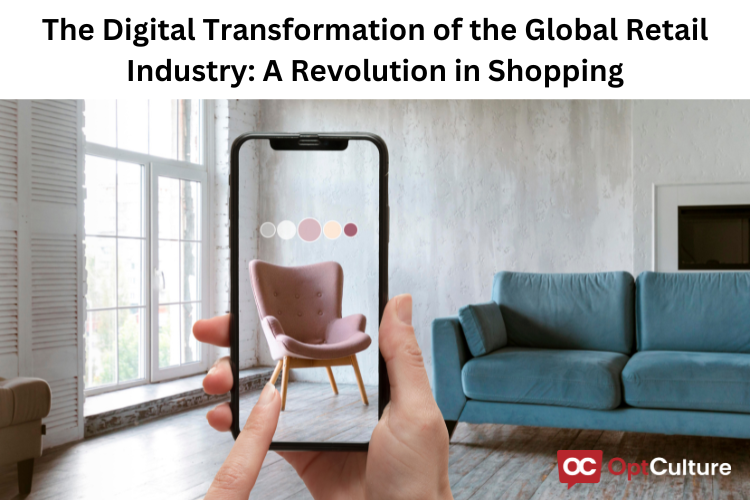
The Digital Transformation of the Global Retail Industry: A Revolution in Shopping
Introduction
The retail industry is undergoing a profound transformation as it embraces digital technologies, reshaping the way consumers shop and businesses operate. In an era dominated by technological advancements, the convergence of e-commerce, artificial intelligence, and data analytics is driving the evolution of the retail landscape worldwide. This digital revolution is not only changing the way products are bought and sold but is also redefining customer expectations and the very essence of the shopping experience.
E-Commerce’s Dominance
One of the most evident trends in the digital evolution of the retail industry is the rise of e-commerce. Online shopping has become an integral part of the consumer experience, offering convenience, variety, and accessibility. The proliferation of smartphones and high-speed internet has accelerated this shift, allowing consumers to browse and purchase products with a few taps on their screens.
Global e-commerce giants like Amazon, Alibaba, and Flipkart have played a pivotal role in shaping the digital retail landscape. They have not only revolutionized the way products are delivered but have also set new standards for customer service and personalization. The success of these platforms has prompted traditional retailers to embrace digital channels, leading to the coexistence of brick-and-mortar stores and online marketplaces.
Personalization and Data Analytics.
Data is the new currency in the digital age, and retailers are leveraging it to enhance customer experiences. Advanced data analytics and machine learning algorithms enable retailers to gather insights into consumer behavior, preferences, and purchasing patterns. Armed with this information, they can create personalized shopping experiences, recommend products tailored to individual preferences, and implement targeted marketing campaigns.
For example, when a customer shops online or in-store, retailers can analyze their browsing history, purchase history, and demographic information to provide personalized recommendations. This level of customization not only enhances customer satisfaction but also increases the likelihood of repeat business.
Augmented Reality (AR) and Virtual Reality (VR)
The integration of augmented reality and virtual reality technologies is transforming the way consumers interact with products in the digital space. AR and VR are breaking down barriers by offering virtual try-on experiences, allowing customers to visualize how products will look in real life before making a purchase.
Furniture retailers, for instance, use AR to enable customers to see how a piece of furniture would fit into their homes. Similarly, fashion brands are employing virtual fitting rooms, where customers can virtually try on clothes and accessories. These immersive experiences not only enhance the online shopping process but also reduce the likelihood of returns, as customers have a clearer understanding of what to expect.
Omnichannel Retailing
The concept of omnichannel retailing is gaining prominence as retailers seek to provide a seamless and integrated shopping experience across various channels—online and offline. Consumers today expect a consistent experience, whether they are shopping on a website, using a mobile app, or visiting a physical store.
Retailers are investing in technologies that bridge the gap between online and offline channels. Click-and-collect services, for example, allow customers to order online and pick up their purchases at a nearby store. This not only caters to the preferences of consumers who enjoy the convenience of online shopping but also maintains a physical presence that fosters brand loyalty.
Supply Chain Innovation
Digital transformation is not limited to the customer-facing aspects of retail; it is also reshaping the supply chain. Technologies such as the Internet of Things (IoT), blockchain, and advanced analytics are optimizing supply chain operations, enhancing efficiency, and reducing costs.
IoT sensors can be embedded in products and packaging, providing real-time visibility into the movement of goods. This not only helps in inventory management but also enables retailers to track product authenticity and traceability through blockchain technology. The result is a more transparent and accountable supply chain that benefits both retailers and consumers.
Conclusion
The digital evolution of the global retail industry is an ongoing and dynamic process that shows no signs of slowing down. E-commerce’s dominance, personalization through data analytics, the integration of AR and VR, omnichannel retailing, and supply chain innovation are collectively shaping a new era of shopping.
As retailers continue to embrace and adapt to these digital transformations, the future promises even more exciting possibilities. Emerging technologies like artificial intelligence, voice commerce, and 5G connectivity are poised to further revolutionize the retail landscape, providing consumers with unparalleled convenience and choice.
In this digital age, success in the retail industry is increasingly tied to a retailer’s ability to innovate, adapt, and harness the power of technology to meet the evolving expectations of today’s consumers. The retail landscape is undergoing a digital renaissance, and those who embrace the change stand to thrive in this new era of commerce.




